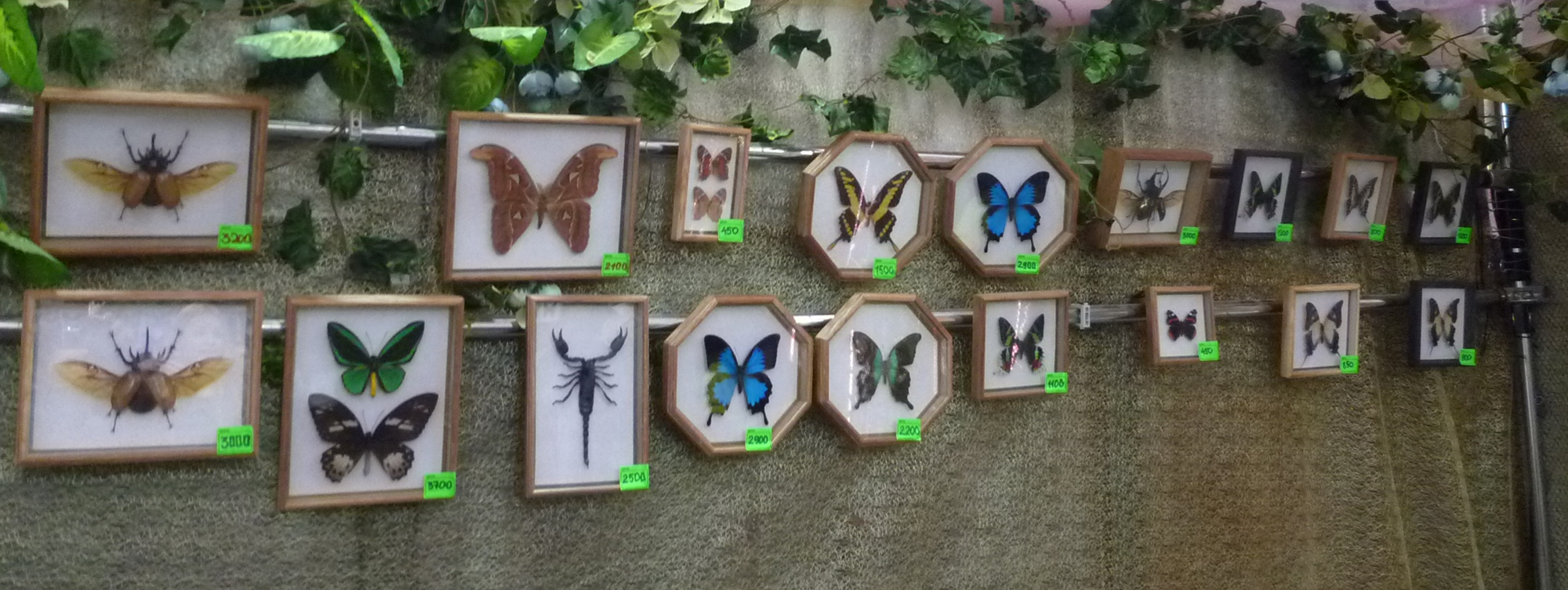Today we are going to have an unusual journey: we are about to visit live tropical butterflies! In this exclusive article for the Special View portal, Anna Demidova, Ph. D. in Biology, staff scientist and tour guide with Moscow State University Botanic Garden, tells about this fantastic world.
The Apothecary Garden, Moscow State University’s Botanic Garden, has a mysterious room. Not many people know about it, and it’s not that easy to find it. But those who manage to do so, both children and adults, are totally delighted, and no wonder: in this room visitors are surrounded by fluttering tropical butterflies! They are real! They are huge, they are bright, and they are flying all around!
Let’s start our journey! The tall glass building with green pillars is the tropical conservatory. It is also called the palm conservatory. This is where one can see majestic old palm trees. Some of them are so big that their tops are a little bit tilted. Just imagine: to make room for these trees the cupola of the building once had to be raised. The second floor is the cacti realm.
We are now in the hall of the conservatory. In front of us, there is a long corridor. Aquascape aquariums are lining the glass wall on the left. The entrance to the conservatory is in the center. To our right, there are grey walls that are often used to exhibit paintings of plants by masters of botanical illustration. Behind this wall, there is a theatre with an unusual name, S.A.D. (“sad” means “garden” in Russian, but it is also an abbreviation standing for The Association of Dramatic Actors). Between you and me, here, in this cozy auditorium which can seat about 80 viewers, wonderful plays are waiting for both children and adults.
Having passed through the tropical conservatory hall and turned to the right, we reach a small cozy rectangular room. This is the insect exhibition. But this is not our destination yet, our journey has merely begun! Pictures and boxes with collectible insects are hanging on the walls. Andrey Sochivko, the author of this collection, is portrayed on one of the photos. He is standing beside an insect trap with a bright lamp above it. Andrey Sochivko collected insects in tropical countries, all around the world, on three continents. Special entomological boxes with glass covers are fixed to the walls. They contain incredible beetles, huge butterflies, stick insects, cicadae, locusts, grasshoppers and mantids! More than one thousand of most amazing insects from all over the planet are exhibited here.
One day I took a group of schoolchildren here, the fifth grade. I showed them the tropical insects collection, told them about the author of the collection.
“Just imagine: all these insects were collected by one person during 45 expeditions in different parts of the world! His name is...”
And at this moment one boy perks up:
“Of course, it is Peter the Great! He founded you garden!”
...But no, it was not the first Russian emperor, but my colleague, Andrey Sochivko. There he was, standing beside a circular table and smiling at our dialog! Andrey is a tall athletically built man, an experienced traveler. He is not just an entomologist and researcher, but also an artist, photographer and a staff member of The Earth Science Museum at Moscow State University. On weekends he works at the Apothecary Garden, enthusiastically tells visitors about his travels to faraway lands, and shows the collections.
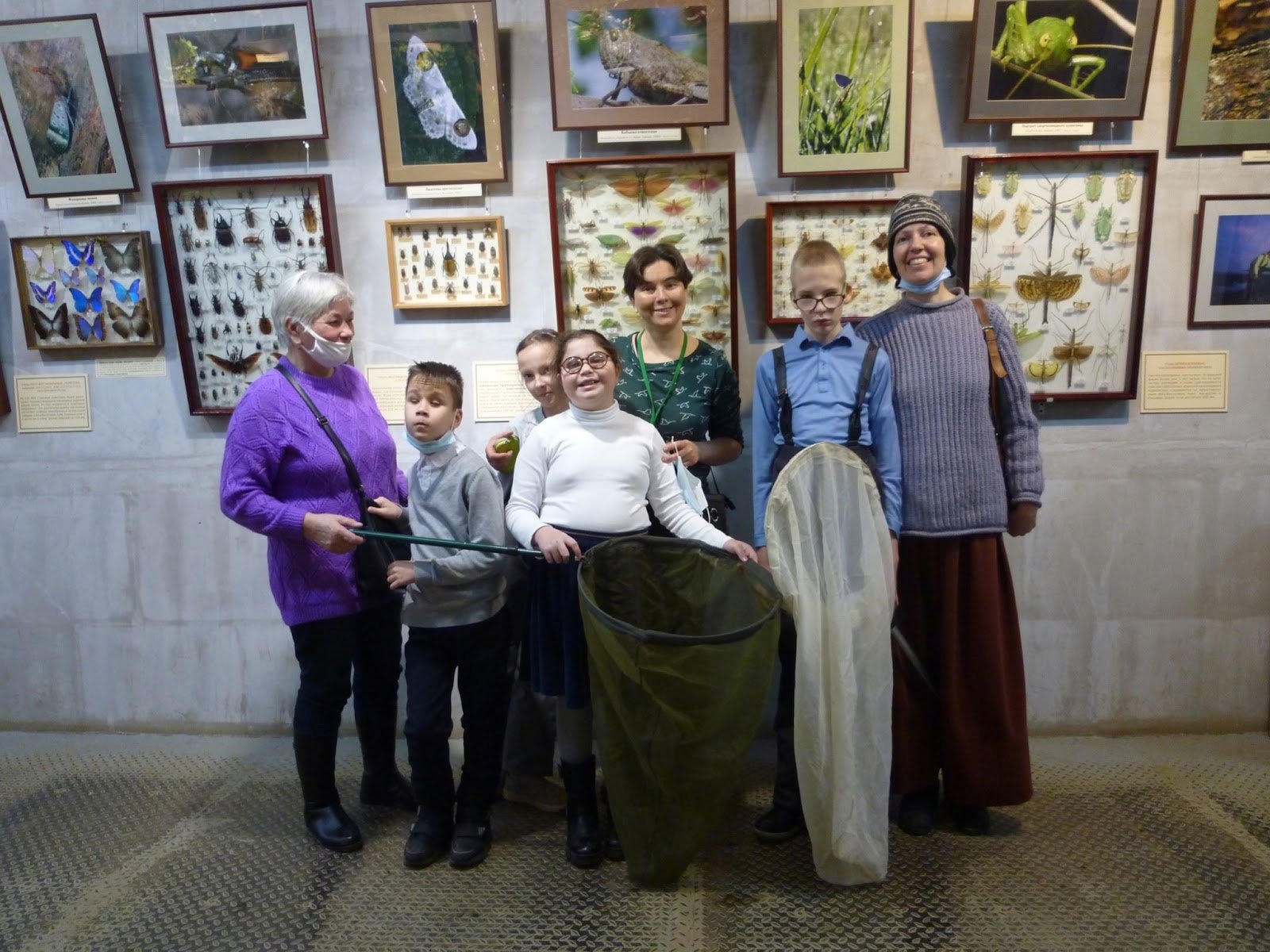
A tour group of children from the Residential School No. 1 for the blind (Moscow) at the insets exhibition with Anna Demidova, the tour guide. Photo by Igor Yeryomkin.
Audio description: a colored photo. Photos and boxes with insect collections are mounted on the wall. A group of six visitors is standing in front of the exhibits: four children and two teachers, with their tour guide, Anna Demidova. A girl in the center and a boy on the right are holding big insect nets.
You can buy collectible items and insects presented as parts of framed paintings; they are hanging on the wall. You can also place an order for a composition made of unusual beetles. The most daring visitors are examining huge furry tarantula spiders, although they, of course, do not classify as insects. All insects have six legs, whereas spiders have eight. Souvenirs are displayed upon a small table: little broaches made of fabric, owls, cats, beaded butterflies. Since recently postcards with landscapes painted by Andrey’s mother are also sold here.
To study all these insects thoroughly, one could spend several hours, even days in this cozy corner, but we are moving to see the flying butterflies! Where can we find them? How can we find them?
Let’s leave the insects exhibition. At the corner to the right we can see a beautiful stag. It is as high as an adult’s waist. Its branchy antlers and its body are made of red and white mosaic. You can pat its back and antlers, make a selfie with it. And at some distance behind the stag we see a room veiled with nets. We can hear children cryout in delight. The butterflies are there! And there we go!
A short passageway. In glass cases on our right there are numerous vials with dried herbs. On our left there are terrariums with chameleons and other animals.
Following the direction signs we proceed to underwater worlds, down to the basement. The room is pleasant and mysterious. It is dimly lit only by the aquariums. Opposite the aquariums there are padded benches for those who wish to stay alone for a while and admire the beauty of the underwater world. Now we are passing the exhibition corner. Not long ago ginseng was displayed here. There were information plates on the walls, and big glass jars with these miracle roots were arranged on the table. Now linen and hemp fibers are exhibited in this corner. Whatever comes next is a mystery! This is the place to visit regularly!
We are passing through a rotating door and going down the stairs. To our right there are framed paintings made of multicolored butterflies and dried grass against white or black background. They are presented by the curio shop called “The Magic Wardrobe”. Now we are entering the restaurant and coffee-shop zone. Oh, these delicious smells! Spicy Vietnamese food, cream coffee, vanilla ice-cream! Turning our backs to the restaurants, we see another staircase.
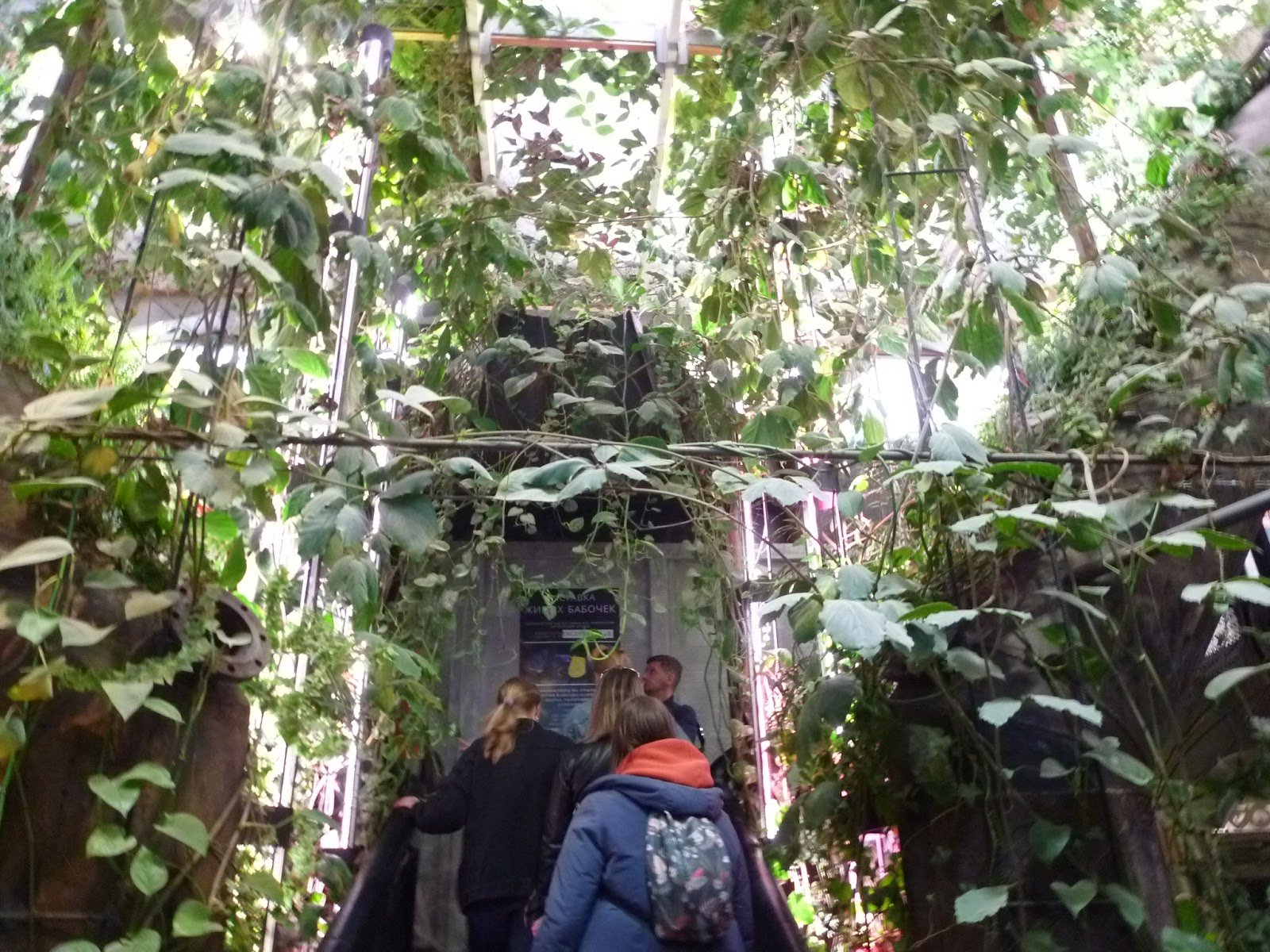
Audio description: a colored photo. Five people are going up the stairs: four women and one man. Real lianas are hanging around and above the staircase.
Such beauty and the feeling of the wondrous tropical world! Big lianas are hanging overhead, their vines are framing the entrance. Our path splits in two here. We choose the left one. And now we see the white curtain with magnetic locks. The room where the tropical butterflies live is right behind it!
It’s warm and humid here. The room is full of exuberant voices of children and grown-ups! Let’s buy a ticket at the table near the entrance. This is also souvenir zone. On the wall, there are two rows of boxes with glass covers and wooden frames of various shapes. Inside the boxes there are large beetles and butterflies with their wings spread. Some cost 300 rubles, some 1000. There is also handmade fashion jewelry made of metal. Here is a broach in the shape of a golden currant leaf, beside it there is a pendant in the shape of an aspen leaf with a blue raindrop frozen upon it. Circular medallions with bright dappled bugs glazed with epoxy resin are hanging on strings. Perhaps you will purchase one of these items as a souvenir.
In the corner opposite the entrance, there is the incubator, a real butterfly farm. It is a smallish vertical box with wooden supports. Through glass walls one can see horizontal wooden strips. Numerous butterfly chrysalides are attached to them, some are brownish, some green. Look, look! This butterfly has emerged merely minutes ago! It doesn’t move, its crumpled wings are hanging limply. It is waiting for the wings to smooth out.
The room where the butterflies live is rectangular and small. Its walls and ceiling are covered with two layers of net. The outer layer is black and wide-meshed. The inner layer is made of white synthetic fine-meshed fabric. A person of average height can easily touch the top of the inner mesh “cupola”. The net on the ceiling is white, and on the walls it looks like yellowish web. Small square spotlights are installed on top. The room is brightly lit. The walls are decorated with artificial ivy-like plants with small pink flowers. In some places the ivy reaches the ceiling. The floor is covered with grey textile carpeting.
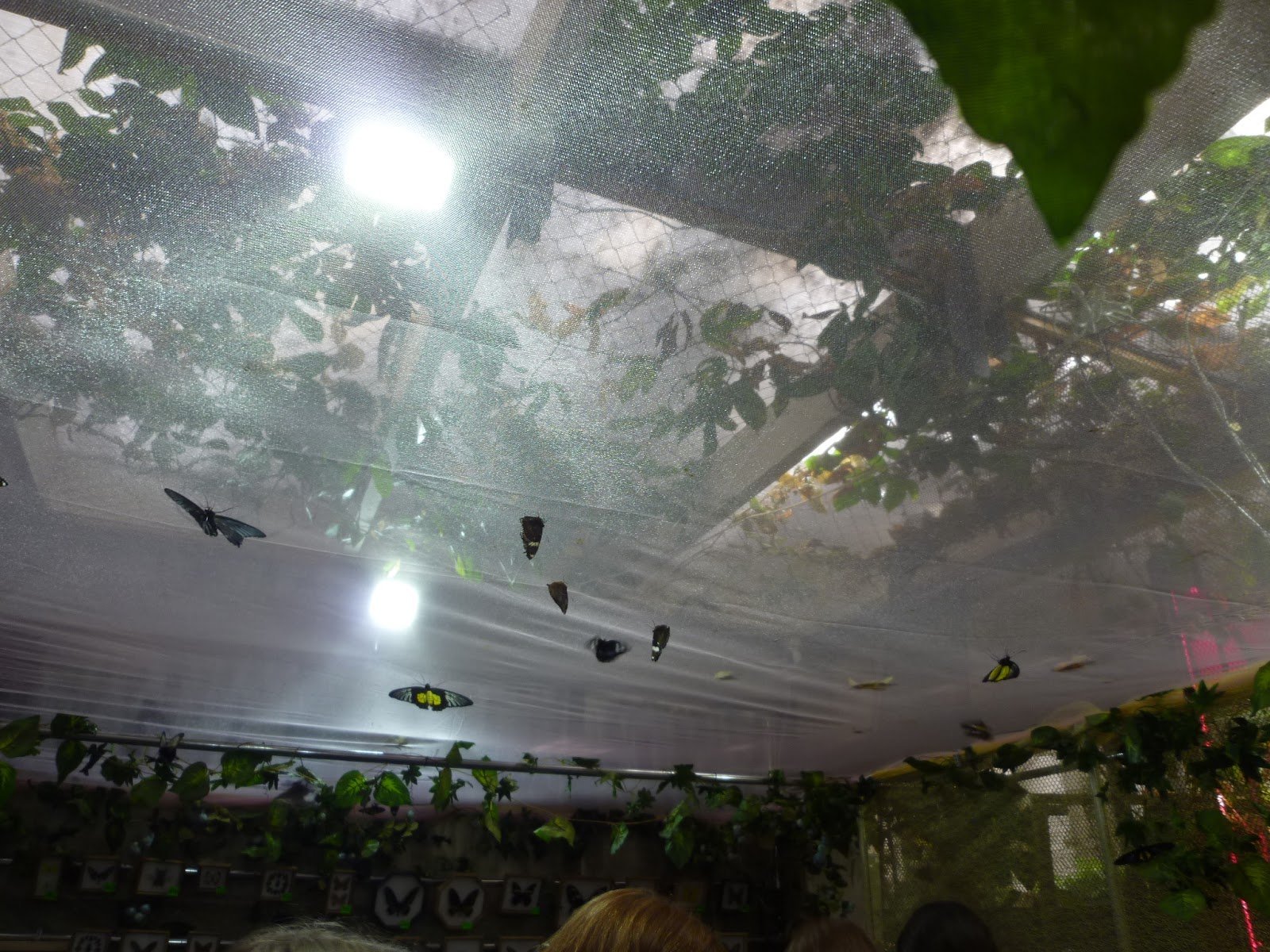
Audio description: a colored photo. Whitish net is stretched below the ceiling. Above the net, there is the roof carcass, bright spotlights and live lianas. Below the net, artificial plants are weaved around a metal bar. On the surface of the mesh, closer to the corner of the room, real tropical butterflies are resting. There are eleven of them in the picture.
Sitting on the net over the walls and ceiling are various tropical butterflies, all of them extremely beautiful, of all colors and sizes! Velvety black ones with bright yellow spots in the center of their hindwings are golden birdwings. Other black ones with red spots on the lover parts of the wings belong to Papilio Rumanzovia species. Black and blue ones with metallic glitter are called Morpho peleides, dappled ones are called Graphium agamemnon, Cethosia biblis and Parthenos Sylvia. Huge orange ones with big eye spots on the wings and feathery antennae are Atlas moths. Their little legs are clinging to the meshes of the net tightly. Some of the butterflies are fluttering and lowering to rest upon the visitors.
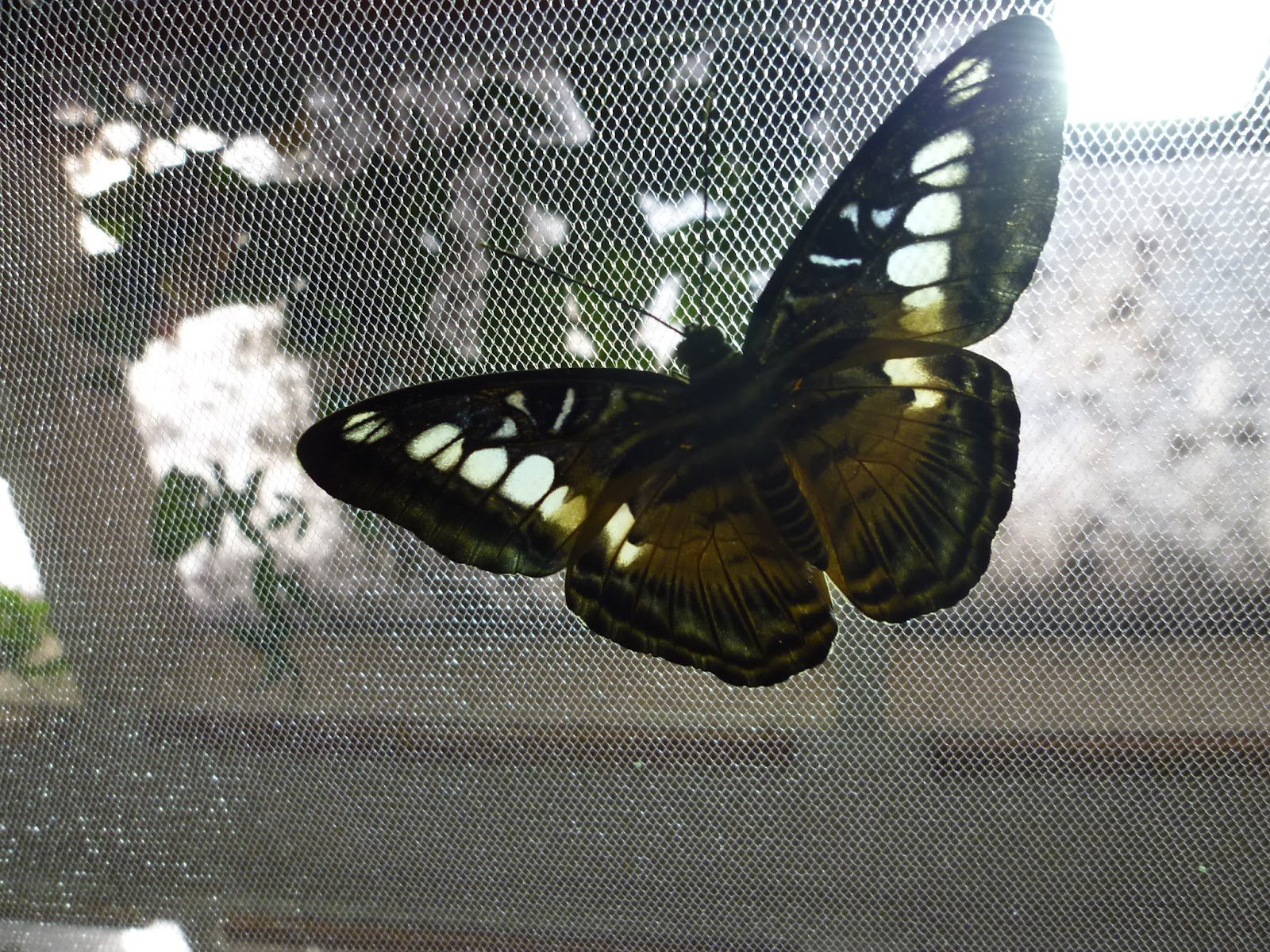
Audio description: a colored photo. A live butterfly is sitting on white fine mesh with its wings spread wide. This is Parthenos Sylvia. The butterfly is dark, its hindwings are yellowish. Pale spots are lining the rims of its forewings.
Children are shrieking in joy! Some have managed to lure a butterfly onto their palms! The visitors around are taking photos and videos. A big brown butterfly has landed onto a young woman’s shoulder. “The butterflies are scary!” a little boy cries. “Don’t be afraid! Butterflies don’t bite,” says his mom to calm him down.
Paintings are hanging on the walls of the room. They are fixed to a metal bar at eye level, so admiring them is quite convenient. These paintings are quite unusual. The background is painted, but the landscape is supplemented with real heroes of the insect world: dried beetles or butterflies. Let’s come closer and look at them more carefully.
The first painting hangs opposite the entrance. A family of elephants is walking across savanna under the blue sky: two adult brownish elephants with white tusks and a baby elephant between them. He turns his head toward his mom. The ears of the big elephants are not painted but formed out of brown butterfly wings with dark brown circular eye spots.
Another paining beside it: a pastel pink rose is painted in wide watercolor strokes against grey background. The rose lies upon a brownish rectangular board. To the right we see dark leaves, and the large flower is on the left. In the very center of the flower, a dark butterfly is sitting on a petal.
One more painting: an almost black rhinoceros beetle is climbing to the top of a mountain. It is about to touch the bright yellow sun with its leg. Snow-covered mountaintops can be seen at the background. Numerous bright rays are radiating from the sun. It resembles a fluffy ball. The mountain is grey, with yellow stripes descending from its peak like sunbeams.
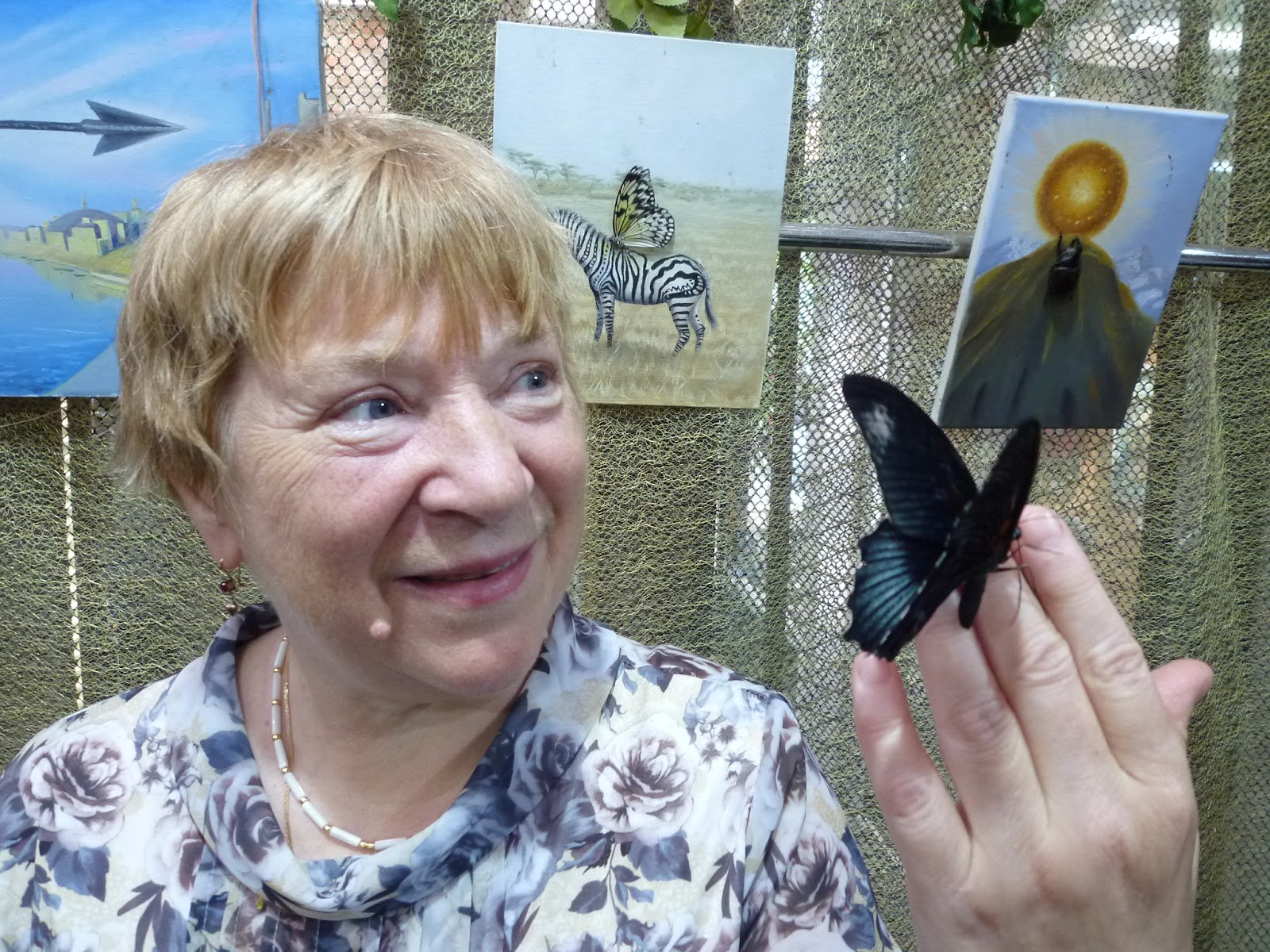
Audio description: a colored photo. In the background, there is a wall covered with grey net. Three paintings are attached to a metal bar. In the first, there is an arrow flying over the sea, in the second one, a zebra with a dappled butterfly on its back is grazing in savanna, and in the third the beetle is climbing the mountain towards the sun. In the foreground the photo portrays Yelena A. Kakorina, the ward of the Connection Deafblind Support Foundation. Her fair hair is cut short, she is wearing a pale blouse with large flowers on it. She is smiling and admiring a black and blue butterfly sitting on the middle fingers of her left hand. The butterfly has raised its wings and is moving its legs.
And here a striped zebra is grazing in the savanna, amidst sunbeaten grasses. A big dappled butterfly has landed on its back. The butterfly is whitish-black with yellowish wing roots. It was dried and glued to the painting as well.
Next, an unusual painting in horizontal format. Bluish background. The sky is merging with the sea. On the left, a dried black butterfly is flying horizontally against the sky. Yellow spots can be seen on its velvety wings. A big black arrow points the butterfly’s way. Far below the arrow, there is an island with castles and domed temples. It is a bright sunny day. Small boats are rocking slightly in the sea.
Now let’s move to the left corner of the room and see what’s hidden there! Another painting: a portrait against a yellow and golden background. A cute grey-eyed girl is looking at is with a shy smile. She has a circlet of colorful meadow grasses, camomiles and bluebells on her head. An orange butterfly has landed on the girl’s brown fringe, and two more brown ones are sitting on the flower circlet.
The paintings are attached to a metal bar. Boxes with insect collections are fixed below them, and lower still there are terrariums with living creatures. A salmon pink bird-eating tarantula is hiding in one of them. It originates from the tropical forests in eastern Brazil. A fully grown spider can be up to 8 of 10 cm in length, the distance between the tips of its legs can amount to 25 cm. It is brown and furry. A Hercules beetle lives in the next terrarium. It is a large yellow beetle with a black “horn”. It is one of the largest beetles on Earth. A male beetle can reach 171 mm in length, a female may grow up to 80 mm. They feed on fruit. Such beetles live in Central and Southern America and on Caribbean islands. The neighbor of the Hercules beetle is a rhinoceros beetle.
Now let’s look at other paintings on the wall.
Blue sky with a few cumulus clouds sailing along it. Grey towers with flags stand in a meadow. Butterflies are sitting on some of them. Another painting: a tall thin man with a big pole resembling a butterfly net is running across a field.
In the corner of the room there is a big horizontal painting: a large yellow and black butterfly spreads its wings against spotted grey background. Below it there is a box with collectible beetles and other insects.
Next, a horizontal painting. The background is blurred: bluish sky with white clouds, a brown field, a green meadow, a meandering river... In the middle there is a thick brown book with rough pages. In its very center, a blue butterfly is painted over the pages. Its wings have brownish rims. The right hindwing looks as if it has broken into glass shards.
Another painting: a red admiral is painted in a somewhat stylized manner over a grey background. Its black wings are fully spread. Bright orange bands rim its hindwings and go along the tops of the forewings. It has white spots in the corners of the forewings.
And here are the exhibits of the collection! Stick insects, or Phasmatodea, are very unusual. Their bodies often resemble a stick of a dry leaf. In the center, there is the giant stick-bug from New Guinea. In the same box, there is a grasshopper from Peru and several cicadae from Southeast Asia.
Another box is fixed to the wall in the corner. It contains dried tarantula. They are large furry spiders. But there are more strange creatures beside them: scorpions, ticks. Let’s read the information plate. Spiders and scorpions are not insects, but they are jointed-legged animals, too. There are more than 2000 species of spiders in the world. This box contains the male and female bird spiders from Brazil. Bird spiders mostly feed on insects, but can also catch a small lizard or a bird on occasion. To the right there are two species of large scorpions from Southeast Asia. Scorpions belong to the Arachnida class. Below them, framed with a black line, are 4 dried ixodic ticks, red with black legs. They are carriers of a dangerous disease, cephalitis. Ticks belong to the Arachnida class, they are not insects. Scientists discovered 10,000 species of ticks. These ones are from Russia.
Look at this marvelous landscape! Blooming meadows at a low river bank, and dried insects looking almost alive are sitting upon flowers.
Uraniidae butterflies are displayed in another wooden frame. One of them is among most beautiful butterflies in the world, Chrysiridia rhipheus from Madagascar. The Apothecary Garden collection has a male specimen. It is a graceful black butterfly. The wing roots are fringed with almost invisible hairs. The forewings have ornaments of bright green stripes, and the stripes on the hindwings are rainbow-colored. The colors merge with one another: azure, green, yellow, reddish and blue. They look like a painter’s palette. Thin tails extend from the butterfly’s hindwings. From the information plaque we learn that the Uraniidae family includes about a hundred species, mostly tropical. Uraniidae are classified as moths, but they are active in daylight. The green Urania leilus lives in Southern America, the big dark Nyctalemon — in Indonesia. Several small species belonging to this family can be found in Russia.
Swallowtails also catch our attention: some are blue, others black with emerald stripes, and still others are bluish brown.
And here are the luxurious Morphinae: blue ones with metallic glow, and brownish ones. The metallic shine of bright turquoise butterflies of the Morpho genus can be seen from many hundreds of meters. The blue metal effect results from the interference of light on transparent scales that cover their wings. There are also white Morphinae and dark ones, and their scales are pigmented, not transparent. Catching Morphinae is not easy as they fly high up amidst the treetops of South American rain forests.
The next box contains examples of mimicry. The motley butterflies resemble veined dried leaves with a bit of mould on them. Some mimic the bright coloring of their poisonous relatives. Such coloring helps them to protect themselves from predators.
A little black table stands in the far right corner of the room. Sometimes the staff put plates with pieces of overripe fruit on it, and also multicolored silicone Pop-It toys (fidget toys with bubbles that people like to poke and turn inside out, with a sound similar to bubble wrap popping) filled with water: this is how they feed the butterflies. A humidifier fills the air around it with thick mist, a small black heater warms the room up. Children always cluster around this table trying to lure the resting butterflies onto their hands, putting their fingers in front of the butterflies’ front legs.
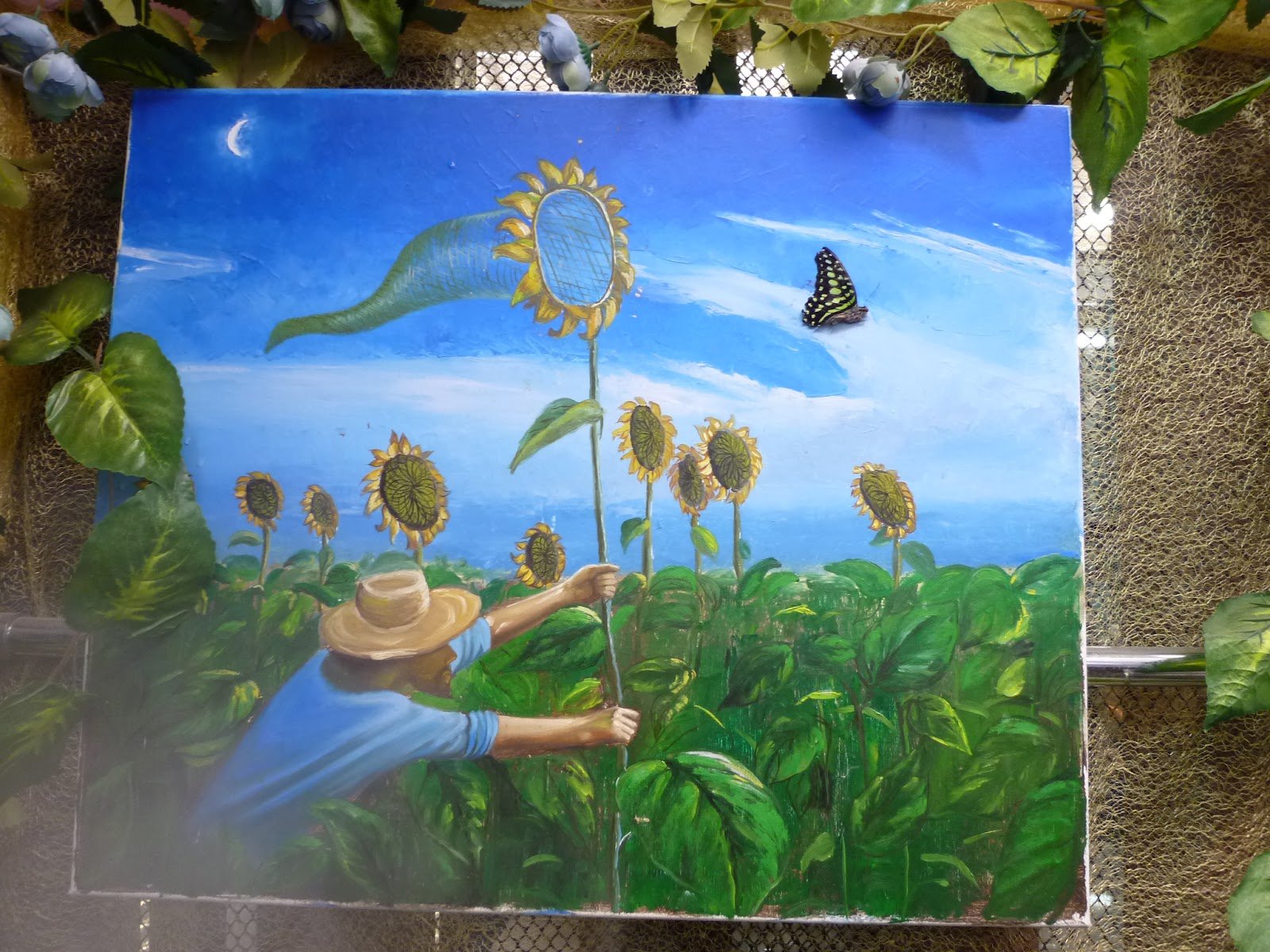
And here we see another painting. A sunflower field, blue sky, but up on the left a thin crescent has come out. In the left corner of the field, amidst the flowers, there is a man wearing a straw hat and a light blue shirt with sleeves rolled up to his elbows. The man is chasing a butterfly that is flying away. The net in his hands looks like a sunflower. The butterfly is glued to the background but looks alive.
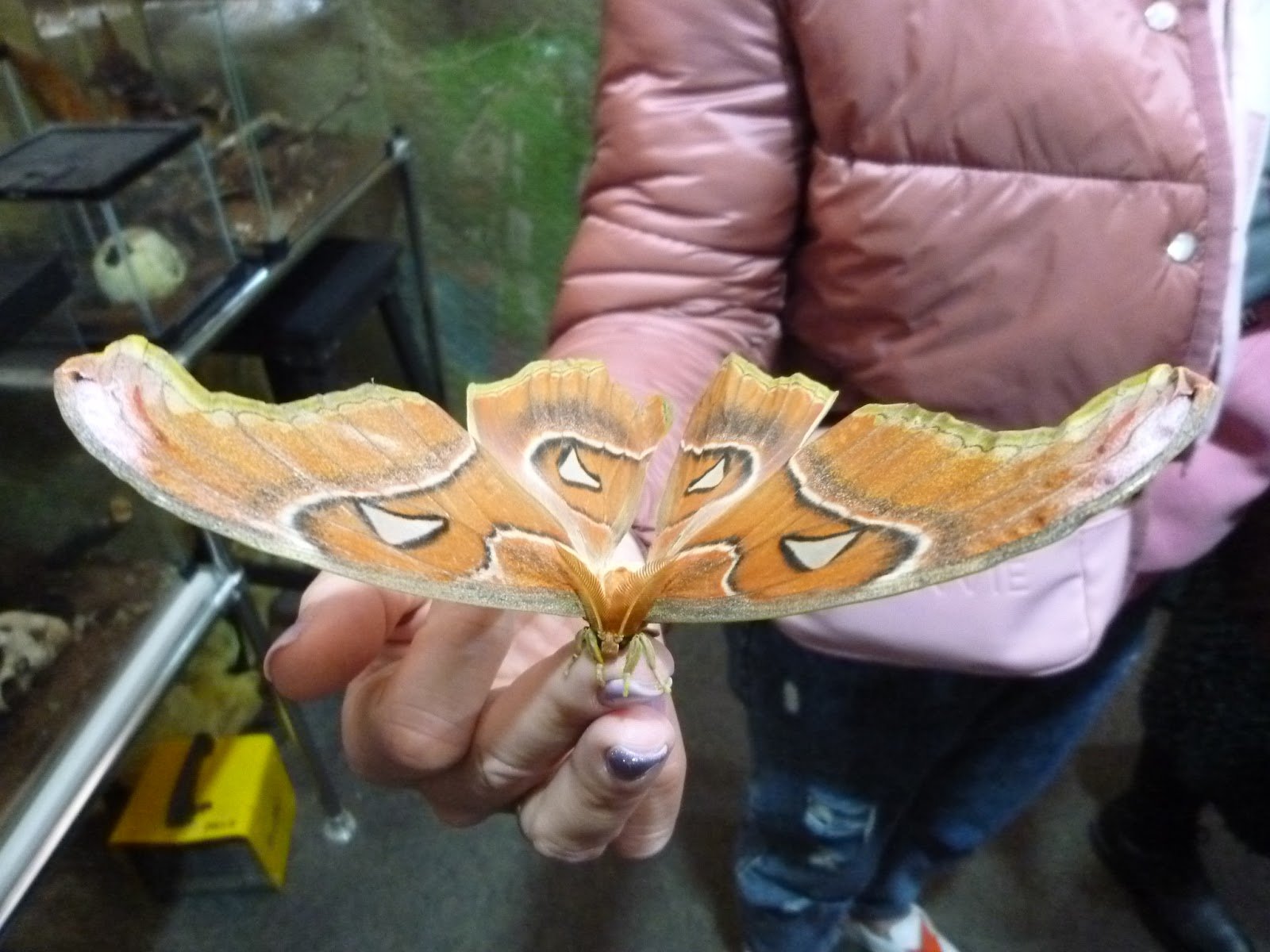
Audio description: a colored photo. Close up. A big rust-colored butterfly with white spots on its wings is sitting on a woman’s hand. This is an Atlas moth, one of the largest butterflies in the world. The butterfly’s head with feathery antennae is turned to the camera. The woman is wearing a reddish jacket and blue jeans, a pink purse is hanging at her waist. On the left of the picture one can see several glass terrariums.
People are reaching their hands and picking the butterflies from the walls and the ceiling, trying to put them onto their clothes and examine them closely. A staff member is walking around the room with a thin stick in his hand. He is picking up the butterflies from the floor and putting them somewhere safe.
...And suddenly I let out a startled cry! A butterfly has brushed my face with is wing, darted sideways and swiftly landed onto the hem of my dress! And at the next moment another one lands higher. The first one flies away at once, and the second one is crawling onto my badge, confidently going up and up! I’m standing very still. This black, velvety butterfly with blue glitter (Papilio Memnon) is sitting on me for a long time looking like a broach. Then we put it on my hand, it stays there for a while showing off its wings and suddenly flutters away.
Grown-ups are delighted like children! A man is enjoying his time here, taking pictures. A magnificent large butterfly with yellow and black wings landed on the face of his lady companion! At first it sat on her nose, then crawled up onto her forehead and stayed to rest there. It sat there for a long time. In mere moments the woman’s face reflected a million of emotions, from panic and fear almost to tears of joy!
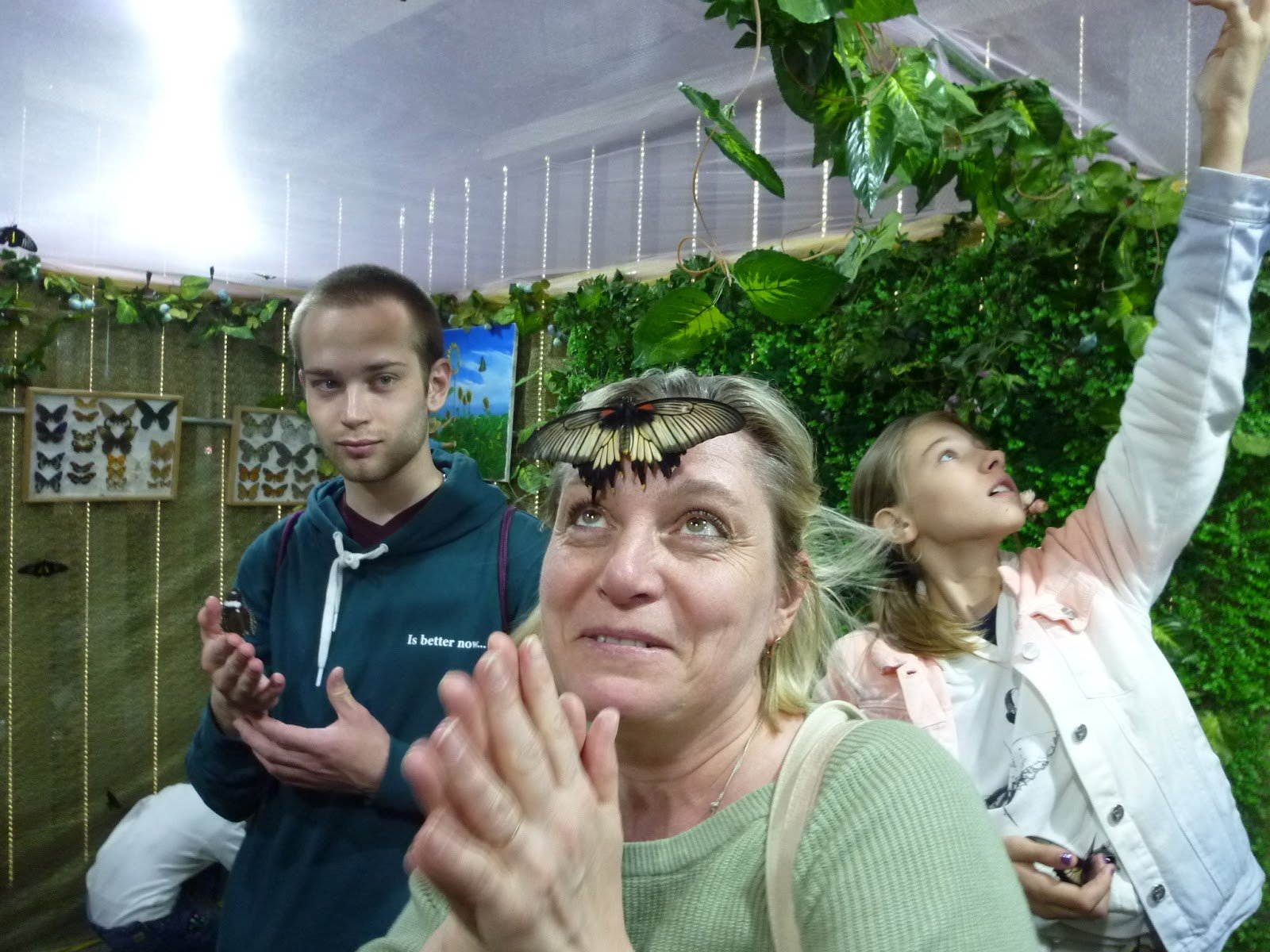
Audio description: a colored photo. The Butterfly Room, bright light. The ceiling is covered with white net. On the far wall, in the corner, there are two boxes with butterfly collections and a bright painting. The wall to the right and the ceiling are decorated with artificial plants. There are three people in the room. In the foreground there is a young woman in a green sweater. She is clasping her hands together as if in prayer. Her gaze is turned upwards. A smile is playing on her face. A big butterfly is sitting on her forehead — it is female Papilio Memnon. It has spread its yellow wings with black rims. Red spots can be seen at the roots of its forewings. A teenage girl is standing to the left of the woman, and a young man with close-cropped hair is on the left. He is holding a butterfly on his right palm.
Leaving this room seems impossible. All the time new butterflies are floating nearer, landing upon us and showing off their beauty on our hands, shoulders and head. So difficult to say goodbye to them! But we will come back again to visit these fluttering flowers!

